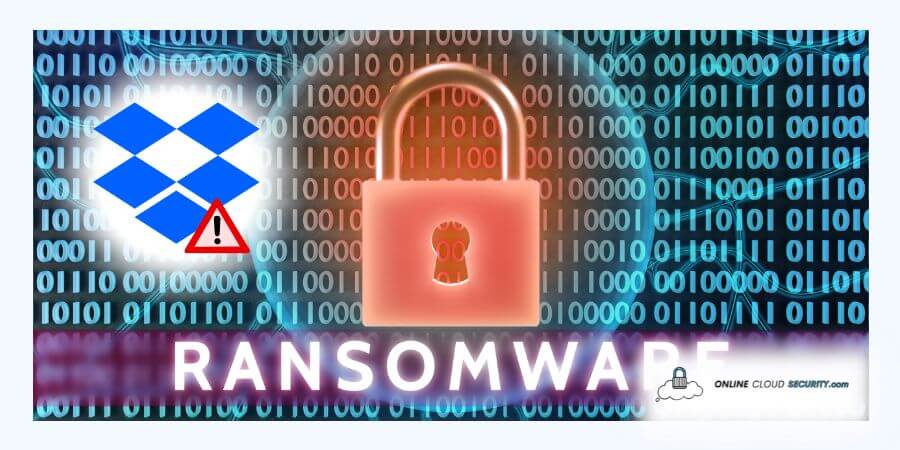
Dave Miller – Tech Enthusiast & Security Expert – August 27th, 2022

Anyone searching for cloud storage should consider Dropbox; however, those who have experienced ransomware attacks question, will ransomware infect my Dropbox files? All online file-hosting services host user files and get generally regarded as secure and safe for keeping your data in the cloud.
They allow you to view files stored in the cloud from any device. The fact that no one has access to the file servers and the system’s overall security makes it incredibly handy.
Consequently, it gives you the comfort you need while entrusting another company with your information. But what about the ongoing cyberattacks, though? Are the files on your Dropbox secure? Questions that haunt many.
Keep reading the article to learn more about how Dropbox functions and what you should do to secure your data.
Dropbox is a file hosting service run by Dropbox, Inc., an American corporation. It was established in 2007 by MIT students. As it continues to develop its capabilities, it has become one of the market’s most well-known cloud storage systems. Growth in the user base clearly shows how well-liked Dropbox is.
After its launch, it saw consistent user growth, surpassing the 700 million user mark in 2021 as registered users held more than 550B+ pieces of material. 15.83M of them are paying customers. Additionally, they are always taking steps to maintain user engagement and turn registered users into paying customers.
Why do users adore DropBox, then? It gives you a folder on your computer that automatically syncs and backs up your data across all your devices while remaining an undetectable programme. Cross-platform file syncing is available on all computers and mobile devices. You will also have access to the cloud to access them from every device, anywhere in the world.
Furthermore, Dropbox makes it simple to share files for personal group work. Dropbox keeps track of the changes made to a particular file by storing the deltas of those files. You will therefore have portable, secure files. The customer user interface experience within
Dropbox is excellent overall. It is pretty simple to create file folders, and it is equally simple to make and handle your files in subfolders. But not to forget that Dropbox has drawn criticism and debate over problems like privacy invasions and security lapses over the years. So, you might wonder if your files are secure from the most dangerous cyberattack: will ransomware infect my Dropbox files?

Consumers prefer to save files in personal cloud storage in the era of digital information. Yet, data security is a significant worry for users. Since 80% of Dropbox members utilise its services for business purposes, this practically means that Dropbox will face increasing demands for security. Due to its prominence, hackers frequently attack it.
So, to reach the correct response for, will ransomware infect my Dropbox files? We must first comprehend the context of these questions.
Dropbox operates by keeping track of the specific folders on your device. Changes to local folders will sync and reflect over the cloud. Therefore, once the malware is active on your computer and has access to everything. And if the infection is ransomware, it could access the information in your local folder. This ransomware, by gaining access to the local storage folder, can attack to encrypt the files that will eventually get synced to Dropbox instead of your original files
So, the answer to your query, “Will Ransomware Infect my Dropbox Files?” is unquestionable yes. Dropbox is just available to sync the existing files because it doesn’t have anything extra to provide the local folder for protection. And you can’t even blame Dropbox for it because you were the one who failed to take measures to stop the ransomware attack. After all, human error accounts for about 90% of data breaches.
As a result, many cyber criminals employ ransomware to encrypt your data, including Dropbox files and then demand a ransom. Your encrypted data could get returned if you pay, but there is no guarantee. If you don’t, your data will continue to be locked and may get misused by thieves.
Fact: Only a quarter of ransomware victims who pay the ransom have their whole data decrypted.
Hence, once you have contracted ransomware, nowhere is secure. Whatever service you use, if the files are on your machine, they can be encrypted. So, what choices are available to you if your data have already got encrypted by ransomware?
Everyone loves Dropbox’s great function, which gets included with the service. Yes, I’m referring to file versioning. The concept behind versioning is that your data cannot get changed after saving it. It is absolute; thus, every modification will create a new version. Versioning is therefore advantageous in the fight against ransomware.
You may restore versions of a file created within the previous 30 days using Dropbox Basic, Plus, and Family accounts.
Versions of a file created within the past 180 days can get recovered using Dropbox Professional and Business accounts.
Therefore, the actions you must do right now if you want to prevent those cloud data from being permanently deleted are listed below.
Step #1: Start remotely signing out of all your devices, including the infected ones.
Step #2: You can choose the necessary files or folders and restore them by going to the version history page for your file. You can click Restore after selecting a previous file version before the ransomware attack. In this way, Your unaffected Dropbox files are simple to retrieve. There are a few things to keep in mind, though. It would help if you knew the infection’s beginning to restore the correct files. Because whether the data is encrypted or not, Dropbox syncs it with its applications and folders.
Step #3: Dropbox Rewind can restore your whole account or a specific folder to a time before the ransomware attack if you need to recover many files. You must be a paid member to utilise this feature. If this function seems challenging to use, you may also contact support for help with rewinding.
Step #4: Make sure your devices are now malware-free, remove the Dropbox folder containing the encrypted data, and then sign back into your computer.
User behaviour is one of the problems with file vulnerabilities in cloud storage. Therefore, in this episode of will ransomware infect my Dropbox files, it also comes down to the user’s precautions. It would help if you took further precautions to safeguard your Dropbox data and the devices synchronising with your account.
It’s wise to choose one of the most effective cyber-secured services if you’re talking about Dropbox security in general. Dropbox uses secure storage servers to encrypt and safeguard all of its online file storage. The security of user data is their priority, and all files kept on Dropbox servers get secured by design. Storage servers get housed in data centres across the United States and other countries. It offers three layers of protection for user files.
It uses the 256-bit Advanced Encryption Standard to secure files at rest
It employs Transport Layer Security (TLS) and Secure Sockets Layer (SSL) to safeguard data during transit.
When logging in, two-step verification is an additional security measure.
Dropbox provides this defence against outside cyberattacks. However, if you are experiencing a widespread ransomware assault, your local Dropbox folder will also start to become encrypted.
Those files would then sync to the cloud and any additional devices you may have if you were using the Dropbox app. Dropbox has no possibility of discovering that the files get encrypted by ransomware. And even if it could, how would it know which files got intentionally encrypted vs those encrypted by ransomware?
There are two ways to delete files on Dropbox. Regular deletion can sometimes get recovered, but permanent deletion is irreversible. Both choices may get found on the online interface. No matter which strategy you use, Dropbox has NO backup for this kind of devastation if hackers manage to have access to it. So, hackers can also delete your files from your local and cloud folder. Following removal, the data will be gone forever from Dropbox Server
Since its debut in 2008, Dropbox has developed further, introducing new services and consistently seeking to surpass its competitors. With the adoption of industry standards, it is intrinsically secure. By default, data stored with cloud services is safer than data stored on your computer’s hard drive. Internet access and a web browser are all required for file storage, making it incredibly simple.
However, the problems with file flaws in cloud storage get caused by your actions, and you often leave loose ends. Therefore, to have access to the restore option, you must take further security precautions with your Dropbox data and purchase a subscription as well. Else you have no hope of restoring the files without that.
**Onlinecloudsecurity.com is a participant in the Amazon Services LLC Associates Program, an affiliate advertising program designed to provide a way for websites to earn advertising revenues by advertising and linking to Amazon.com and affiliated sites. As an Amazon Associate we earn affiliate commissions from qualifying purchases.**

Dave Miller is an IT Consultant for Online Cloud Security and has over 7 years of experience in the Information Technology space. He also specializes in repairing laptops & computers. In his spare time, he loves to talk about new technologies and hosts monthly IT and Cyber Security meetings in the Houston area.
Click any button down below to share this article on the following channels:

Online Cloud Security is here to recommend you the most secure devices, from laptops to smartphones, we only want to provide you with products that we have tested and used ourselves for online security. Every product that we recommend is heavily inspected and tested for security against hackers, viruses, malware, and any other intruders that may want to steal your information.

Online Cloud Security is here to recommend you the most secure devices, from laptops to smartphones, we only want to provide you with products that we have tested and used ourselves for online security. Every product that we recommend is heavily inspected and tested for security against hackers, viruses, malware, and any other intruders that may want to steal your information.
Your Trusted Source for Online Security